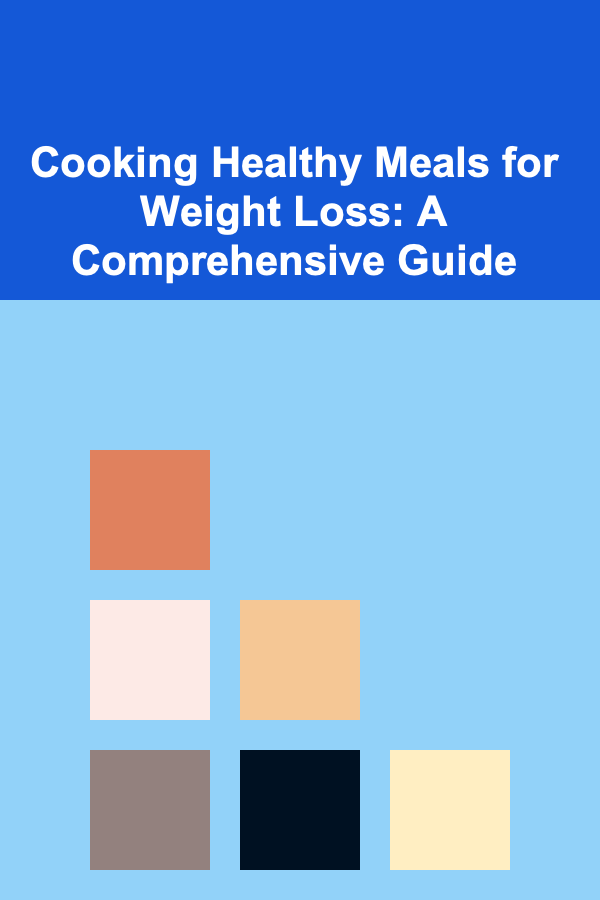
Cooking Healthy Meals for Weight Loss: A Comprehensive Guide
ebook include PDF & Audio bundle (Micro Guide)
$12.99$8.99
Limited Time Offer! Order within the next:

Losing weight and maintaining a healthy lifestyle involves a combination of factors, with diet playing a pivotal role. While many approaches to weight loss exist, the most sustainable and effective strategy often involves learning to cook healthy, delicious meals at home. This guide provides a comprehensive overview of how to cook healthy meals for weight loss, covering everything from foundational principles to practical tips and example recipes.
Understanding the Fundamentals of Healthy Eating for Weight Loss
Before diving into recipes, it's crucial to understand the core principles that underpin healthy eating for weight loss. These principles aren't just about restricting calories; they're about nourishing your body with the right nutrients to support metabolism, satiety, and overall well-being.
Calorie Balance: Energy In vs. Energy Out
Weight loss fundamentally revolves around creating a calorie deficit -- consuming fewer calories than you burn. However, simply cutting calories drastically can be counterproductive. It can lead to nutrient deficiencies, muscle loss, and a slowed metabolism. A more effective approach involves creating a moderate calorie deficit (around 500-750 calories per day) while prioritizing nutrient-dense foods.
Calculating Your Calorie Needs: There are several online tools and formulas (like the Mifflin-St Jeor equation) that can help you estimate your daily calorie needs based on your age, gender, weight, height, and activity level. Consulting a registered dietitian or nutritionist is recommended for personalized guidance.
Macronutrient Balance: The Power of Protein, Carbs, and Fats
Macronutrients are the building blocks of our diet, and each plays a crucial role in weight loss and overall health:
- Protein: Essential for building and repairing tissues, protein is also highly satiating, meaning it helps you feel fuller for longer. Aim for 1.2-1.7 grams of protein per kilogram of body weight, especially if you're engaging in regular exercise. Good sources include lean meats (chicken, turkey, fish), eggs, beans, lentils, tofu, and Greek yogurt.
- Carbohydrates: Your body's primary source of energy. Focus on complex carbohydrates like whole grains (brown rice, quinoa, oats), fruits, and vegetables. These are digested more slowly, providing a sustained release of energy and preventing blood sugar spikes. Limit refined carbohydrates like white bread, pasta, and sugary drinks, which offer minimal nutritional value and can contribute to weight gain. Carb intake should be tailored to your activity level and individual needs.
- Fats: Often demonized, fats are essential for hormone production, vitamin absorption, and brain function. Choose healthy fats like monounsaturated and polyunsaturated fats found in avocados, nuts, seeds, olive oil, and fatty fish (salmon, tuna). Limit saturated and trans fats found in processed foods, fried foods, and fatty cuts of meat.
Micronutrient Density: Vitamins and Minerals
Vitamins and minerals are crucial for countless bodily functions, including metabolism, immune function, and energy production. A diet rich in fruits, vegetables, and whole grains provides a wide range of essential micronutrients. Consider a multivitamin if you suspect you're not meeting your nutritional needs through diet alone (consult with a doctor or registered dietitian first).
Fiber's Role in Weight Loss
Fiber is a type of carbohydrate that your body cannot digest. It contributes to satiety, helps regulate blood sugar levels, and promotes healthy digestion. Good sources of fiber include fruits, vegetables, whole grains, legumes, and nuts. Aim for at least 25-35 grams of fiber per day.
Hydration: The Underrated Key
Drinking enough water is essential for weight loss and overall health. Water helps you feel full, boosts metabolism, and aids in digestion. Aim for at least 8 glasses of water per day, and increase your intake during exercise or in hot weather. Sometimes thirst is mistaken for hunger, so staying hydrated can prevent unnecessary snacking.
Strategies for Healthy Meal Planning and Preparation
Effective meal planning and preparation are crucial for staying on track with your weight loss goals. Here are some strategies to help you succeed:
Weekly Meal Planning: Set Yourself Up for Success
Take some time each week (e.g., on Sunday) to plan your meals for the upcoming week. This helps you avoid impulsive, unhealthy food choices when you're hungry and pressed for time.
- Create a Menu: List out your breakfast, lunch, and dinner for each day of the week.
- Build your Shopping List: Based on your menu, create a detailed shopping list. This will help you avoid buying unnecessary items and stay focused on healthy ingredients.
- Consider Theme Nights: Designate specific nights for certain types of meals (e.g., "Meatless Monday," "Taco Tuesday"). This can simplify meal planning and add variety to your diet.
- Use Recipe Websites and Apps: Explore online resources for healthy and delicious recipes. Many websites and apps allow you to filter recipes based on dietary restrictions, calorie counts, and macronutrient ratios.
Batch Cooking: Save Time and Effort
Batch cooking involves preparing large quantities of food at once, which can then be stored and used throughout the week. This is a great way to save time and ensure you always have healthy options available.
- Cook Grains in Bulk: Prepare a large batch of brown rice, quinoa, or oats and store it in the refrigerator for use in various meals.
- Roast Vegetables: Roast a variety of vegetables (broccoli, carrots, sweet potatoes) at the beginning of the week and add them to salads, soups, or stir-fries.
- Prepare Protein Sources: Grill chicken breasts, bake fish fillets, or cook a pot of lentils and store them in individual portions for easy meal assembly.
- Make Soups and Stews: Soups and stews are excellent for batch cooking. They're packed with nutrients, fiber, and flavor, and they freeze well.
Smart Grocery Shopping: Choose Wisely
The grocery store can be a minefield of unhealthy temptations. Here are some tips for making smart choices:
- Shop with a List: Stick to your shopping list to avoid impulse purchases.
- Shop the Perimeter: The perimeter of most grocery stores is where you'll find fresh produce, lean meats, and dairy products. Spend most of your time in these sections.
- Read Nutrition Labels: Pay attention to serving sizes, calories, fat content, sugar content, and fiber content.
- Choose Whole, Unprocessed Foods: Opt for whole, unprocessed foods whenever possible. These foods are typically lower in calories and higher in nutrients.
- Be Mindful of Marketing Claims: Don't be swayed by misleading marketing claims like "low-fat" or "sugar-free." Always read the nutrition label to see what you're actually getting.
Mastering Healthy Cooking Techniques
The way you cook your food can have a significant impact on its nutritional value and calorie content. Here are some healthier cooking techniques:
- Baking: A healthy way to cook meat, vegetables, and even some desserts. It requires little to no added fat.
- Grilling: Grilling adds flavor without adding extra calories. Be mindful of marinades, which can be high in sugar and sodium.
- Steaming: Steaming preserves the nutrients in vegetables better than boiling.
- Sautéing: Use a small amount of healthy oil (olive oil, avocado oil) and cook foods quickly over medium-high heat.
- Poaching: A gentle cooking method ideal for delicate proteins like fish and eggs.
- Air Frying: A great alternative to deep-frying, air frying uses hot air to cook food with minimal oil.
Controlling Portion Sizes: A Key to Weight Loss
Even healthy foods can contribute to weight gain if consumed in excess. Pay attention to portion sizes to ensure you're not overeating.
- Use Smaller Plates and Bowls: Studies have shown that using smaller plates and bowls can help you eat less.
- Measure Your Food: Use measuring cups and spoons to accurately portion your meals.
- Don't Eat Straight from the Container: Portion out your snacks into a bowl or bag instead of eating directly from the container.
- Be Mindful While Eating: Pay attention to your hunger cues and stop eating when you're satisfied, not stuffed.
Sample Healthy Meal Ideas for Weight Loss
Here are some sample meal ideas to inspire your own healthy cooking:
Breakfast Ideas
- Oatmeal with Berries and Nuts: A filling and nutritious breakfast packed with fiber, antioxidants, and healthy fats.
- Greek Yogurt with Fruit and Granola: High in protein and calcium, this breakfast is a great way to start your day. Choose granola with low sugar content.
- Scrambled Eggs with Vegetables: A protein-rich breakfast that's quick and easy to prepare.
- Smoothie with Protein Powder, Fruits and Greens: Add spinach, kale or other greens.
Lunch Ideas
- Salad with Grilled Chicken or Fish: A light and refreshing lunch packed with protein and nutrients. Use a vinaigrette dressing instead of creamy dressings.
- Whole-Wheat Wrap with Hummus, Vegetables, and Lean Protein: A convenient and portable lunch option.
- Leftovers from Dinner: A great way to save time and avoid food waste.
- Lentil Soup: High in fiber and protein, lentils are a great base for a filling and healthy soup.
Dinner Ideas
- Baked Salmon with Roasted Vegetables: A healthy and delicious dinner that's rich in omega-3 fatty acids and nutrients.
- Chicken Stir-Fry with Brown Rice: A quick and easy dinner that's packed with flavor and vegetables.
- Turkey Meatloaf with Mashed Sweet Potatoes and Green Beans: A healthier twist on a classic comfort food.
- Black Bean Burgers on Whole Wheat Buns with Salad: Vegetarian and satisfying.
Snack Ideas
- Apple slices with peanut butter
- A handful of almonds or walnuts
- Greek yogurt with berries
- Baby carrots with hummus
- Hard-boiled egg
Healthy Recipe Examples
Here are a few simple and delicious healthy recipes to get you started:
Grilled Chicken Salad with Lemon Vinaigrette
- Ingredients:
- 4 oz Grilled Chicken Breast, sliced
- 4 cups Mixed Greens
- 1/2 cup Cherry Tomatoes, halved
- 1/4 cup Cucumber, sliced
- 1/4 cup Red Onion, thinly sliced
- 2 tbsp Lemon Vinaigrette (recipe below)
- Lemon Vinaigrette:
- 2 tbsp Olive Oil
- 1 tbsp Lemon Juice
- 1 tsp Dijon Mustard
- Salt and Pepper to taste
- Instructions:
- Combine mixed greens, cherry tomatoes, cucumber, and red onion in a bowl.
- Top with grilled chicken slices.
- Drizzle with lemon vinaigrette.
Quinoa Bowl with Roasted Vegetables and Chickpeas
- Ingredients:
- 1 cup Cooked Quinoa
- 1 cup Roasted Vegetables (broccoli, carrots, sweet potatoes)
- 1/2 cup Chickpeas, drained and rinsed
- 1 tbsp Olive Oil
- 1 tbsp Lemon Juice
- Salt and Pepper to taste
- Instructions:
- Combine quinoa, roasted vegetables, and chickpeas in a bowl.
- Drizzle with olive oil and lemon juice.
- Season with salt and pepper to taste.
Baked Salmon with Asparagus
- Ingredients:
- 4 oz Salmon Fillet
- 1 cup Asparagus Spears
- 1 tbsp Olive Oil
- 1 tbsp Lemon Juice
- Salt and Pepper to taste
- Instructions:
- Preheat oven to 400°F (200°C).
- Place salmon fillet and asparagus spears on a baking sheet lined with parchment paper.
- Drizzle with olive oil and lemon juice.
- Season with salt and pepper to taste.
- Bake for 12-15 minutes, or until salmon is cooked through and asparagus is tender.
Overcoming Challenges and Staying Motivated
Cooking healthy meals for weight loss can be challenging, especially at first. Here are some common challenges and tips for overcoming them:
Time Constraints
Many people struggle to find the time to cook healthy meals. Batch cooking, meal prepping, and using quick and easy recipes can help you overcome this challenge.
Lack of Cooking Skills
If you're not confident in your cooking abilities, start with simple recipes and gradually work your way up to more complex dishes. There are many online resources and cooking classes that can help you improve your skills.
Temptations and Cravings
Cravings are a natural part of weight loss. Plan ahead for cravings by having healthy snacks on hand. You can also try to identify the triggers for your cravings and find healthy ways to cope with them.
Social Situations
Eating out or attending social events can be challenging when you're trying to lose weight. Plan ahead by checking the menu online or asking the host what food will be served. Make healthy choices and don't be afraid to say no to unhealthy options.
Plateaus
It's common to experience plateaus during weight loss. If you're not seeing results, re-evaluate your diet and exercise plan. You may need to adjust your calorie intake or increase your activity level. It can also be helpful to track your food intake and exercise to identify any areas where you can improve.
The Importance of Consistency and Patience
Weight loss is a journey, not a destination. It takes time and effort to lose weight and keep it off. Be patient with yourself and don't get discouraged if you have setbacks. The key is to stay consistent with your healthy eating habits and exercise routine. Celebrate your successes and learn from your mistakes. With dedication and perseverance, you can achieve your weight loss goals and improve your overall health.
Tip: Consider using a food journal or a calorie-tracking app to monitor your progress and stay accountable.
Important: Consult with a healthcare professional or a registered dietitian before making any significant changes to your diet or exercise routine, especially if you have any underlying health conditions.

How to Shop for Budget-Friendly Furniture That Looks High-End
Read More
How to Soundproof Your Bathroom to Eliminate Echoes
Read More
How to Use QR Codes for Quick Home Inventory Access
Read More
How to Maintain Your Chainsaw for Safe and Effective Use
Read More
How to Integrate Security Testing into Your Workflow
Read More
10 Tips for Sustainable Field Research Practices
Read MoreOther Products

How to Shop for Budget-Friendly Furniture That Looks High-End
Read More
How to Soundproof Your Bathroom to Eliminate Echoes
Read More
How to Use QR Codes for Quick Home Inventory Access
Read More
How to Maintain Your Chainsaw for Safe and Effective Use
Read More
How to Integrate Security Testing into Your Workflow
Read More